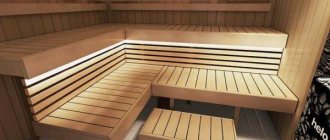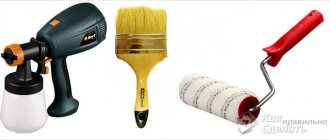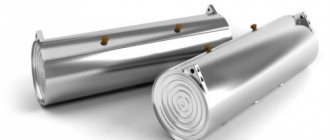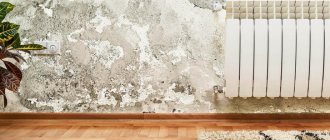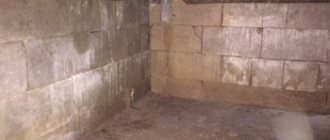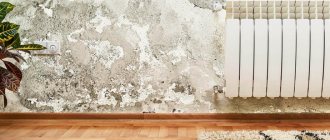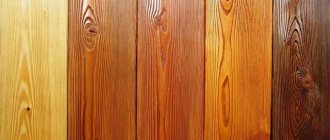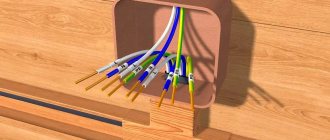It is not enough to design and build a beautiful and durable house made of wood; it is necessary to protect it from a common and difficult problem - mold. It grows quickly and destroys timber, logs, boards, cladding elements and carved decor. It is necessary to take timely and effective measures to combat the fungus, don’t you agree?
For zealous owners, we have collected and presented all the effective ways to exterminate the fungus and stop its spread. Here you will learn how to remove mold from wooden surfaces and what to do to permanently destroy fungal colonies.
We offer you to get acquainted with folk remedies and factory-produced household chemicals, and describe in detail the technology for using the compositions. Useful information is complemented by illustrations, step-by-step photo instructions and video tips.
The diverse and dangerous world of mold
The first signal that there is mold in the house is a change in the color of wooden surfaces, the appearance of characteristic blue, brown, pink and whitish spots, gray stains and a moistened surface. Some fungi do not destroy the texture and do not penetrate deep into the wood, but they spoil the appearance of wooden wall cladding, floorboards, and ceiling trim.
Not only in country houses built from rounded logs or timber, but also in city apartments with a poorly adjusted ventilation system or drafts, mold appears. For example, on the lining, which is often used to decorate a balcony or loggia, unpleasant dark spots may appear.
Colonies of black mold appear on boards much less often than on stone, brick or tile grout, and blue mold is a frequent guest in houses made of timber.
If during the construction of a house the timber or log was not treated with antiseptic impregnation, pale ink stains of mold, called “blue”, will soon appear on the wooden surface.
Fungi like the very common blue fungus completely change the color of wood. They feed on protein, starch, sugar and grow quite quickly - a spot can double in size in just 10 days. But for this, one condition is necessary - the moisture content of the wood is higher than normal.
Blue is not believed to affect strength characteristics, so spore-contaminated timber and lumber are often tested for suitability, and mold may be present in a batch of lumber intended for renovation work.
The most dangerous fungus for wood is putrefactive fungus. It feeds on the fibers of the material, breaking them down with secreted enzymes. First, bright brown spots appear on the surface of boards and logs, and after a few weeks or months the wooden elements become unusable.
At the initial stage, you can still get rid of the fungus by cutting and thoroughly polishing the surface (if possible), but if the mold penetrates deep into the board or log, you can no longer save it
Sometimes the process of development of the hearth occurs secretly: several subtle stains appear on the upper part, but active destruction occurs inside. “Sick” parts of the cladding or frame can be recognized by a dull knock. A durable-looking timber, affected by rot, breaks when pressed.
Mold is harmful not only to the wood itself, but also to people who inhale air contaminated with spores. If there are allergy sufferers in the house, they will always feel unwell when outbreaks occur. Small fungi are also dangerous for healthy people - they can provoke the occurrence or exacerbation of various diseases of the respiratory system.
Image gallery
Photo from
The appearance of blue mold on a new log house
Result of lack of ventilation
The result of using non-galvanized fasteners
Lack of waterproofing in baths and toilets
The most vulnerable and susceptible to mold in a wooden house is the bathroom or combined toilet. The shower room suffers in the same way, even if the box is perfectly sealed and does not allow drops of water to pass through.
Therefore, when installing hygienic rooms in buildings made of timber or logs, it is imperative to follow the technologies for their organization and use protective antiseptic agents.
Causes of wood destruction
Let's assume that the inside of the house was lined with absolutely healthy boards. However, over time, they also began to turn blue and gradually become covered with ugly stains. What does this come from?
Mold reproduces by spores that are present absolutely everywhere - in the forest, in the fields, on the roads. It is estimated that forest-dwelling species living on living trees cover approximately 40% of the surface area of the trunks and branches of these trees and shrubs. They do not destroy bark and other tissues, but make them more porous.
Spores are easily carried by wind, animals and even shoes. If microorganisms, by any of the listed methods, enter a house where favorable conditions have been created for them, they quickly begin to multiply. The ideal conditions for the existence of mold are high humidity (from 70%) and temperature from +5ºС to +30ºС.
Good ventilation and moderate humidity are two conditions necessary to prevent mold in areas where water is constantly used, such as the bathroom
Wood is just one of the materials on which entire colonies of fungi settle. They can grow on rubble stone, concrete, plaster, paper and even plastic.
Owners of seasonal country houses in central Russia know very well: if you do not regularly heat a wooden house or do not monitor the condition of the basement and foundation, then dark spots will certainly appear in the corners, on the ceiling and even on the furniture.
The same problem threatens cellars and wooden baths if ventilation is not organized in them. Even the interior lining of the clapboard can become infected with fungus and become completely unusable if it does not have the opportunity to ventilate and dry out.
The lack of air circulation also favors the rapid growth of mold colonies. This can be seen in city apartments, where bathrooms are lined with wood panels and ventilation is poor.
If the surface of the panels is not treated with a protective compound, they will soon become covered with a light white or black coating, and over time the cladding will take on a neglected appearance.
Pinotex Base – deep impregnation for the top layer of wood, acts as a primer and antiseptic. Used in combination with decorative products - Pinotex Wood Oil, Pinotex Classic, etc.
Thus, the reasons for the appearance of fungus or mold are the lack of waterproofing, disruptions in ventilation, and high air humidity.
Sulfur checker
If you don’t know how to get rid of mold in the basement of a wooden house, use a sulfur bomb. This is a fine aerosol that, when combined with air, forms a deadly mixture for fungus and its spores. At the same time, the smallest particles easily penetrate the narrowest crevices of wooden surfaces, being an effective way in the fight against mold.
Traditional methods of getting rid of fungus
When using what are commonly called folk remedies, you need to remember three points:
- their use is often remembered when it is too late and more effective solutions are needed;
- It is difficult to remove overgrown lesions with household solutions, and when they are destroyed there is always a risk of new colonies appearing;
- When getting rid of mold, you need to simultaneously eliminate the causes that gave rise to it.
Let's look at the available products that you can find at home or buy.
Treatment with chlorine bleaches
Stores sell a solution that is traditionally called “Whiteness”. The compositions of different manufacturers may differ, but the main substance does not change - it is sodium hypochloride, a powerful antiseptic and oxidizing agent.
At chemical plants, it is used to disinfect water and various surfaces; in everyday life, it is used to bleach fabrics and disinfect bathrooms.
Do not forget that any products containing chlorine are potentially hazardous to human health. If they enter the respiratory tract, they can cause vomiting, dizziness, and, with increased doses, poisoning, so it is necessary to use protective equipment: mask, gloves, respirator
When using the solution, it is important to determine that it is diluted with water in a ratio of 1:10, but to combat mold, a more powerful antiseptic is needed, so the proportions change to 1:1.
Whiteness is ideal for smooth surfaces such as tiles or hard plastic. Wood has a porous texture, which is very difficult to process, so a chlorine solution is only suitable for removing external signs, stains and stains; it will not save you from deep penetration of fungus.
The concentrated composition is applied in several layers with a paint brush, then washed off with clean water. If the fire is in an inaccessible place (in the attic), the product does not need to be washed off.
Pharmacy antiseptic solutions
Hydrogen peroxide, which is used to treat wounds and scratches, also works great against fungus. As a rule, a small bottle of peroxide can always be found in the first aid kit, so nothing prevents you from doing a little experiment.
Moisten a cotton pad with a few drops of the solution and wipe the mold-affected wooden surface. If the stains disappear, you can process the already clean area several more times.
Like chlorine-containing substances, you don’t need to expect miracles from peroxide. You can use it to clean tiles, porcelain tiles, enameled or concrete surfaces, but wood is a soft material and cannot be quickly “treated”
If you purchased a bottle of 3% solution, do not dilute it with water, this concentration is not considered strong. It is enough to apply peroxide to the damaged area and leave for a while, then repeat the procedure.
The second solution “from the pharmacy” is ammonia, which is included in products for cleaning windows and washing the print heads of inkjet printers. It also works effectively on smooth surfaces (glass, earthenware, plastic), and with moderate success on wood (or plasterboard).
The procedure should be carried out according to the same rules as with “Belizna”: dilute in a 1:1 ratio, do not forget to wear gloves and a respirator.
The use of "kitchen" products
At least two products used to combat mold can be found in your kitchen cabinet. This is vinegar and soda.
Vinegar, like Belizna, is not able to completely remove mold, but, unlike it, it is absolutely safe for humans. It is not diluted with water, but is applied in large quantities to the infected areas using a roller, brush or sponge.
To increase efficiency, do not use weak table solutions, but vinegar essence or acid, which is more concentrated
If the mold on a wooden surface resembles plaque, then there is a chance of getting rid of it completely. However, do not forget about the persistence of harmful microorganisms and wipe the areas at risk every 2 weeks - until you correct the ventilation and insulate the room.
Soda is also one of the safest remedies. It is often used for cleaning children's clothes and washing dishes. However, when paired with vinegar, it can destroy a small colony of mold. If you notice a scattering of small black dots on the walls, dilute baking soda in vinegar and wipe the infected area.
The vinegar-soda solution can be placed in a spray bottle and sprayed on the walls (floor, ceiling, attic floors, exterior of the house) every 2-3 hours.
Soda does not harm wood, so this option is also possible: pour a small amount of powder onto a slightly dampened cloth and rub into the damaged area, and then rinse with water.
Professional mold control
There is another effective method for removing an unpleasant “guest” - calling specialists.
They can do things that the residents of the house cannot do on their own:
- will diagnose the microclimate using high-precision instruments;
- analyze the condition of the affected objects;
- will conduct an examination and draw up a conclusion on the nature of the occurrence of mold on wooden surfaces;
- will select the most effective professional products and treat areas of fungal growth with biocides;
- They will neutralize indoor air using UV installations.
If necessary, professionals will carry out construction work: increase the efficiency of ventilation, reduce heat loss by laying insulation, and restore normal humidity by installing waterproofing.
Installing a reliable ventilation system in a wooden house will ensure a normal level of humidity and conditions under which mold cannot develop and destroy the wood.
The main advantage of professional treatment of the room is the guarantee that mold will not bother you in the near future. The most responsible companies undertake to carry out repeated measures to eliminate newly emerging outbreaks.
If you decide to call a team of specialists, take care to document the order. The contract for the provision of services must include a warranty period and indicate a list of procedures performed. If workers carry out construction activities, they must be guided by the requirements of GOST and SanPiN.
How to get rid of mold in a wooden house
Simply removing mold from the walls is not enough - the results will not last long and the problem will soon return. The correct technology for removing mold is to first eliminate its cause: waterproof the basement, ensure effective ventilation, allocate funds for insulation and create an optimal heating system.

